Complete Solutions to Solved Examples of chapter KINETIC THEORY OF GASES AND FIRST LAW OF THERMODYNAMICS of Class 11 book with complete answers and questions
| Class 11 | PHYSICS |
| Chapter | KINETIC THEORY OF GASES AND FIRST LAW OF THERMODYNAMICS |
| CENGAGE PHYSICS | Solved Examples |
| Number Of Questions | 14 |
| Academic Year | 2023-24 |
A vessel containing 1 g of oxygen at a pressure of 10 atm a temperature of `47^(@)C`. It is found that because of a leak, the pressure drops to `5//8th` of its original value and the temperature falls to `27^(@)C`. Find the volume of the vessel and the mass of oxygen that is leaked out.
View SolutionAn ideal gas (2.0 moles) is carried round a cycle as shown. If the process `b rarr c` is isothermal and `C_(V) = 3 cal//mol//K`. Determine
a. work done,
b. change in internal energy,
c. heat supplied to the system during processes `a rarr b`, `b rarr c` and `c rarr a`.
View SolutionFigure. Shows three processes for an ideal gas. The temperature at 'a' is 600 K, pressure of atm, and volume 1 L. The volume at 'b' is 4 L. Out of two processes, ab and ac, one is adiabatic and other is isothermal. The ratio of specific heats of the gas is 1.5.
a. Which of the processes ab and ac is adiabatic ? Why
b. Compute the pressure of the gas at b and c.
c. Compute the temperature at b and c.
d. Complete the volume at c.
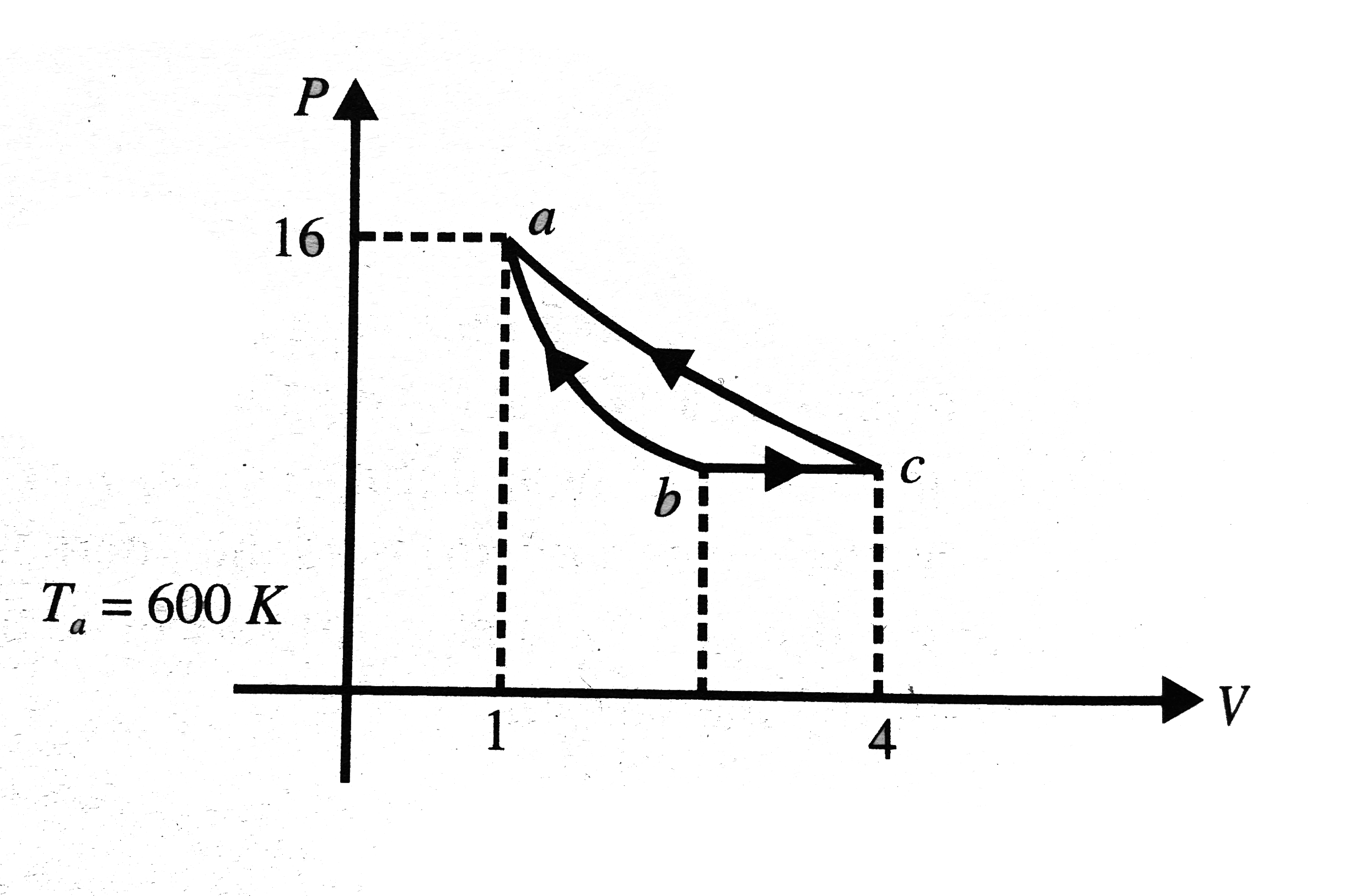
View SolutionN molecules each of mass m of gas A and 2 N molecules each of mass 2m of gas B are contained in the same vessel which is maintined at a temperature T. The mean square of the velocity of the molecules of B type is denoted by `v^(2)` and the mean square of the x-component of the velocity of a tye is denoted by `omega^(2)`. What is the ratio of `omega^(2)//v^(2) = ?`
View SolutionTwo moles of an ideal monoatomic gas is taken through a cycle ABCA as shown in the P-T diagram. During the process AB , pressure and temperature of the gas very such that `PT=Constant`. It `T_1=300K`, calculate
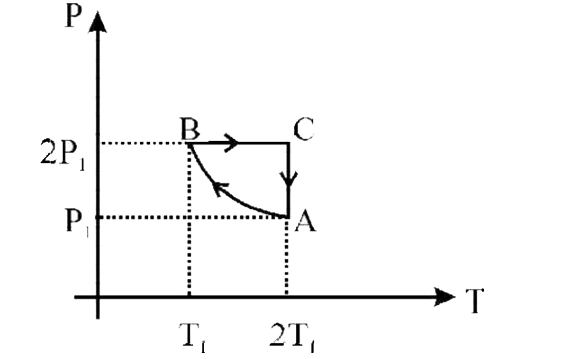
(a) the work done on the gas in the process AB and
(b) the heat absorbed or released by the gas in each of the processes. Give answer in terms of the gas constant R.
View SolutionA smooth vertical tube having two different cross sections is open from both the ends but closed by two sliding pistions as shown in Fig. and tied with an inextensible string. One mole of an ideal gas is enclosed between the piston The difference in cross-sectional areas of the two pistons is given `Delta S`. The masses of piston are `m_(1)` and `m_(2)` for larger and smaller one, respectively. Find the temperature by which tube is raised so that the pistons will be displaced by a distance l. Take atmospheric pressure equal to `P_(0)`
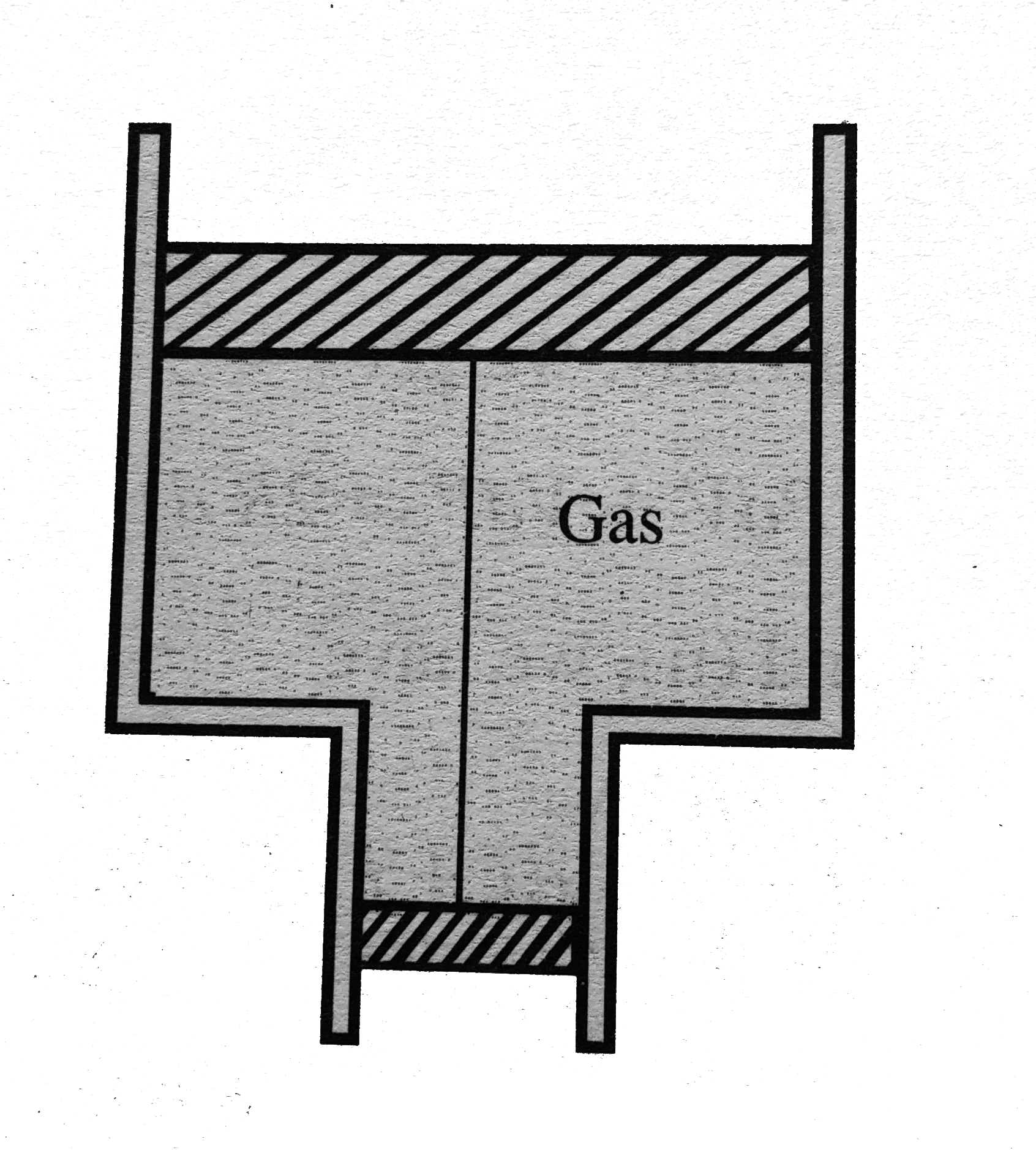
View SolutionTwo moles of helium gas`(lambda=5//3)` are initially at temperature `27^@C` and occupy a volume of 20 litres. The gas is first expanded at constant pressure until the volume is doubled. Then it undergoes an adiabatic change until the temperature returns to its initial value.
(i) Sketch the process on a p-V diagram.
(ii) What are the final volume and pressure of the gas?
(iii) What is the work done by the gas ?
View SolutionAn ideal monoatomic gas is confined in a cylinder by a spring-loaded piston of cross-section `8.0xx10^-3m^2`. Initially the gas is at 300K and occupies a volume of `2.4xx10^-3m^3` and the spring is in its relaxed (unstretched, unompressed) state, fig. The gas is heated by a small electric heater until the piston moves out slowly by 0.1m. Calculate the final temperature of the gas and the heat supplied (in joules) by the heater. The force constant of the spring is `8000 N//m`, atmospheric pressure is `1.0xx10^5 Nm^-2`. The cylinder and the piston are thermally insulated. The piston is massless and there is no friction between the piston and the cylinder. Neglect heat loss through lead wires of the heater. The heat capacity of the heater coil is negligible. Assume the spring to be massless.
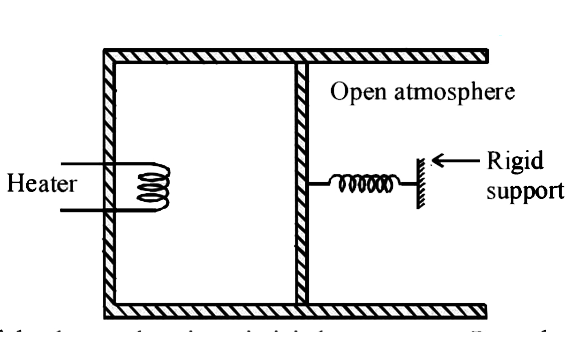
View SolutionThree moles of an ideal gas `(C_p=7/2R)` at pressure, `P_A` and temperature `T_A` is isothermally expanded to twice its initial volume. It is then compressed at constant pressure to its original volume. Finally gas is compressed at constant volume to its original pressure `P_A`.
(a) Sketch P-V and P-T diagrams for the complete process.
(b) Calculate the net work done by the gas, and net heat supplied to the gas during the complete process.
View SolutionTwo moles of helium gas undergo a cyclic process as shown in Fig. Assuming the gas to be ideal, calculate the following quantities in this process
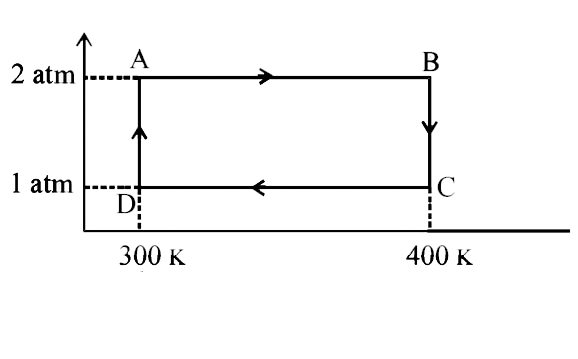
(a) The net change in the heat energy
(b) The net work done
(c) The net change in internal energy
View SolutionOne mole of a monoatomic ideal gas is taken through the cycle shown in Fig:
`AtoB`: adiabatic expansion
`BtoC`: cooling at constant volume
`CtoD`: adiabatic compression
`DtoA`: heating at constant volume

The pressure and temperature at A,B,etc. are denoted by `P_A, T_A,P_B,T_B`etc. respectively. Given that `T_A=1000K`, `P_B=(2//3)P_A and P_C=(1//3)P_A`, calculate the following quantities:
(i) The work done by the gas in the process `AtoB`
(ii) The heat lost by the gas in the process `BtoC`.
(iii) The temperature `T_D`. [Given :`(2//3)^(2//5)=0.85`]
View SolutionA sample of 2 kg of monatomic helium (assumed ideal) is taken through the process ABC another sample of 2 kg of the same gas is taken through the process ADC as shown in Fig. Given molecular mass of helium = 4.
a. What is the temperature of helium in each of the states A, B, C and D ?
b. Is there any way of telling afterwards which sample of helium went through the process ABC and which went through the process ADC ? Write yes or no.
How much is the heat involved in each of the process ABC and ADC ?
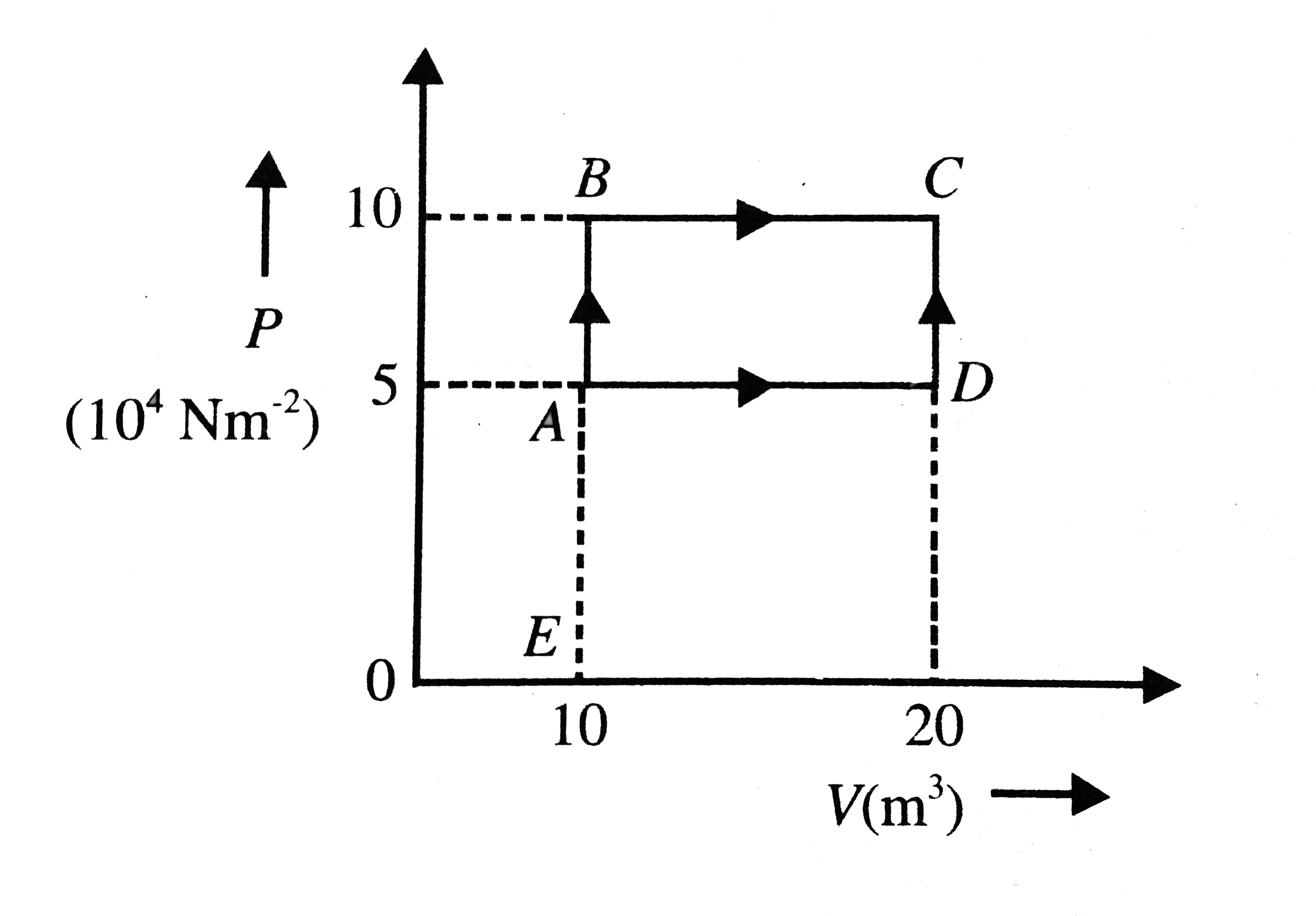
View SolutionOne mole of an ideal monatomic gas is taken round the cyclic process ABCA as shown in figure. Calculate
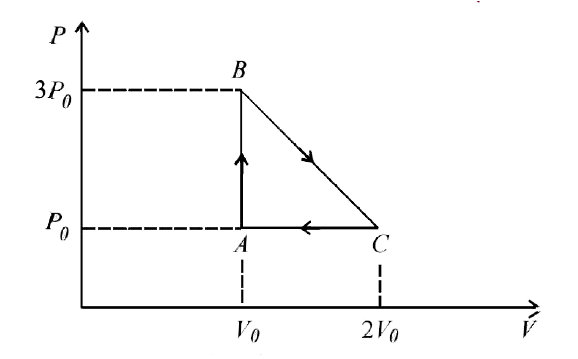
(a) the work done by the gas.
(b) the heat rejected by the gas in the path CA and the heat absorbed by the gas in the path AB,
(c) the net heat absorbed by the gas in the path BC,
(d) the maximum temperature attained by the gas during the cycle.
View SolutionA masslesss piston divides a closed thermallyy insulated cylinder into two equal parts. One part contains M = 28 g of nitrogen. At this temperature, one-third of molecules are dissociated into atoms and the other part is evacuated. The piston is released and the gas fills the whole volume of the cylinder at temperature `T_(0)`. Then, the piston is slowly displaced back to its initial position. calculate the increases in internal energy of the gas. Neglect further dissociation of molecules during, the motion of the piston.
View Solution
Solved Examples questions and complete solutions for chapter KINETIC THEORY OF GASES AND FIRST LAW OF THERMODYNAMICS of CENGAGE PHYSICS (HINGLISH) of Class 11